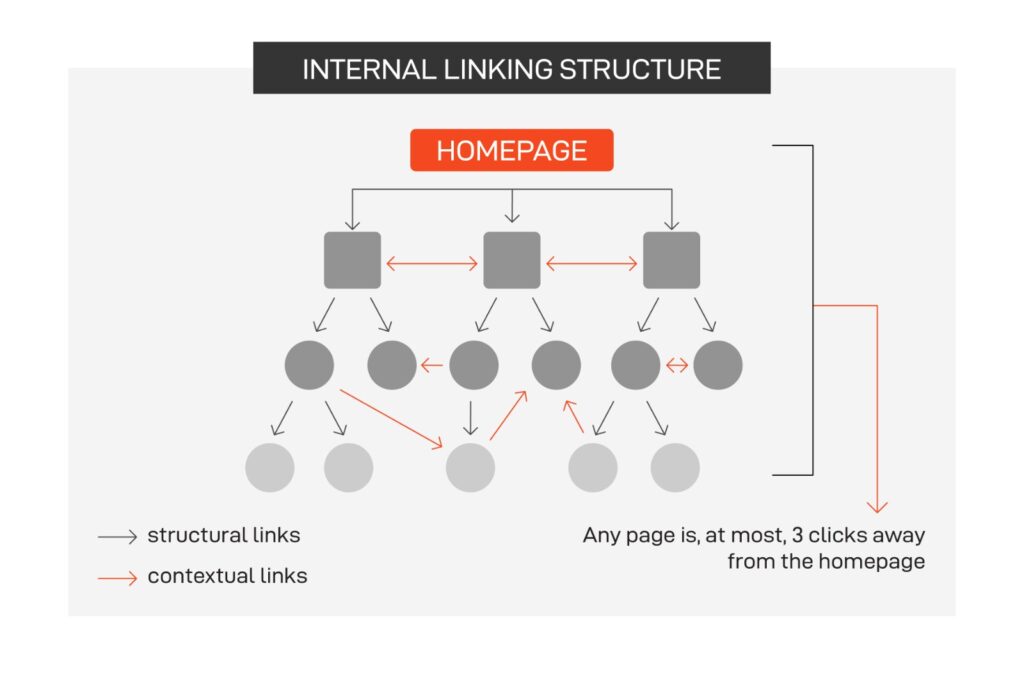Mastering the role of Internal Linking for SEO: A Path to Enhanced Website Traffic

In this article, our objective is to highlight the significance of internal linking in SEO, specifically focusing on how it can be harnessed to increase website traffic. By the end of this piece, you will have a deeper understanding of the role internal linking plays in your overall SEO strategy, and you’ll gain actionable insights on how to use internal linking techniques to drive more organic traffic to your website.
As a trusted SEO agency, we know that a well-optimized website is not just about keywords and backlinks. One of the often underestimated but highly effective strategies in the realm of search engine optimization is internal linking. In this comprehensive article, we delve into the pivotal role of internal linking in SEO. Our aim is to provide you with a clear understanding of how internal linking can boost your website’s traffic and improve its search engine rankings. Learn how to effectively use internal links to not only enhance user experience but also drive more organic traffic to your site.
In the dynamic world of search engine optimization (SEO), there’s a multitude of factors that influence a website’s visibility and ranking on search engine results pages (SERPs). One often underestimated yet highly effective technique is internal linking. Internal linking involves connecting different pages within your own website through hyperlinks. This strategy isn’t just about enhancing user experience, it plays a pivotal role in SEO by contributing to your site’s structure, user engagement, and overall search engine ranking. Let’s delve into the importance of internal linking and how it can significantly impact your website’s success.

Internal linking is the practice of connecting different pages within your own website through hyperlinks. These links enable users to easily navigate from one page to another on the same site. Beyond enhancing user experience, internal linking aids search engine crawlers in understanding your site’s structure and hierarchy. By strategically placing links, you guide visitors to relevant content, reduce bounce rates, and distribute authority across your website. This SEO strategy not only improves navigation but also contributes to better search engine rankings by ensuring all valuable content gets indexed and displayed in search results. Let’s delve into the importance of internal linking and how it can significantly impact your website’s success.
Role of Internal Linking for SEO
1. Establishing a Cohesive Site Structure
When search engine crawlers visit your website, they follow links to discover and index content. Internal links help them navigate your site’s architecture and hierarchy, making it easier for them to understand how your pages are interconnected. A well-structured website with logical linking can enhance the crawlability of your site, ensuring that all your valuable content gets indexed and ultimately appears in search results.
2. Enhancing User Experience
While SEO is undeniably important, user experience should never be overlooked. Internal links serve as a roadmap for visitors, guiding them through your site and helping them discover related content that might interest them. By offering relevant and valuable links, you keep users engaged, increase their time spent on your site, and reduce bounce rates – all of which are positive signals that search engines take into account when evaluating the quality of a website.
3. Distributing Page Authority
Search engines determine the importance of a webpage through various metrics, one of which is Page Authority (PA). PA is a measure of a page’s credibility and relevance, which directly affects its ranking potential. By strategically placing internal links from high-authority pages to those that require a ranking boost, you can distribute authority across your site. This can elevate the visibility of lower-ranking pages, potentially leading to improved search engine rankings.
4. Keyword Relevance and SEO
Internal linking also provides an opportunity to optimize your anchor text – the clickable words within a hyperlink. By using relevant keywords as anchor text, you signal to search engines what the linked page is about. This can contribute to the overall SEO of that page and improve its chances of ranking for those specific keywords.
5. Deepening Content Exploration
Your website likely houses a plethora of valuable content that might not be easily discoverable through the main navigation menu alone. Internal links offer a way to direct users to deeper layers of your content, encouraging them to explore more of what your site has to offer. This not only keeps users engaged but also increases the likelihood of pages getting indexed and ranked.
6. Decreasing Bounce Rates
When a user visits a single page on your website and then leaves without interacting with any other pages, it’s known as a bounce. High bounce rates can be detrimental to your SEO efforts, as they indicate that users aren’t finding what they’re looking for. Internal links guide users to other relevant content, reducing bounce rates and signaling to search engines that your site provides value to visitors.
7. Enhancing Topic Clusters
Topic clustering is an SEO strategy that involves organizing related content into groups. Internal linking plays a pivotal role in this approach, as it connects articles or pages that share similar themes or keywords. By creating topic clusters and interlinking them, you can demonstrate to search engines that your website is an authoritative source on a particular subject, potentially boosting your rankings for related keywords.
In conclusion, internal linking is far more than a simple navigational tool within your website. It’s a strategic SEO practice that contributes to your site’s structure, user experience, and overall search engine visibility. By using internal links strategically, you can guide search engine crawlers, improve user engagement, distribute authority, optimize keywords, and deepen content exploration. These combined benefits can lead to enhanced SEO performance and ultimately a stronger online presence for your website. So, take the time to carefully plan and implement an effective internal linking strategy – your website’s ranking and success depend on it.






